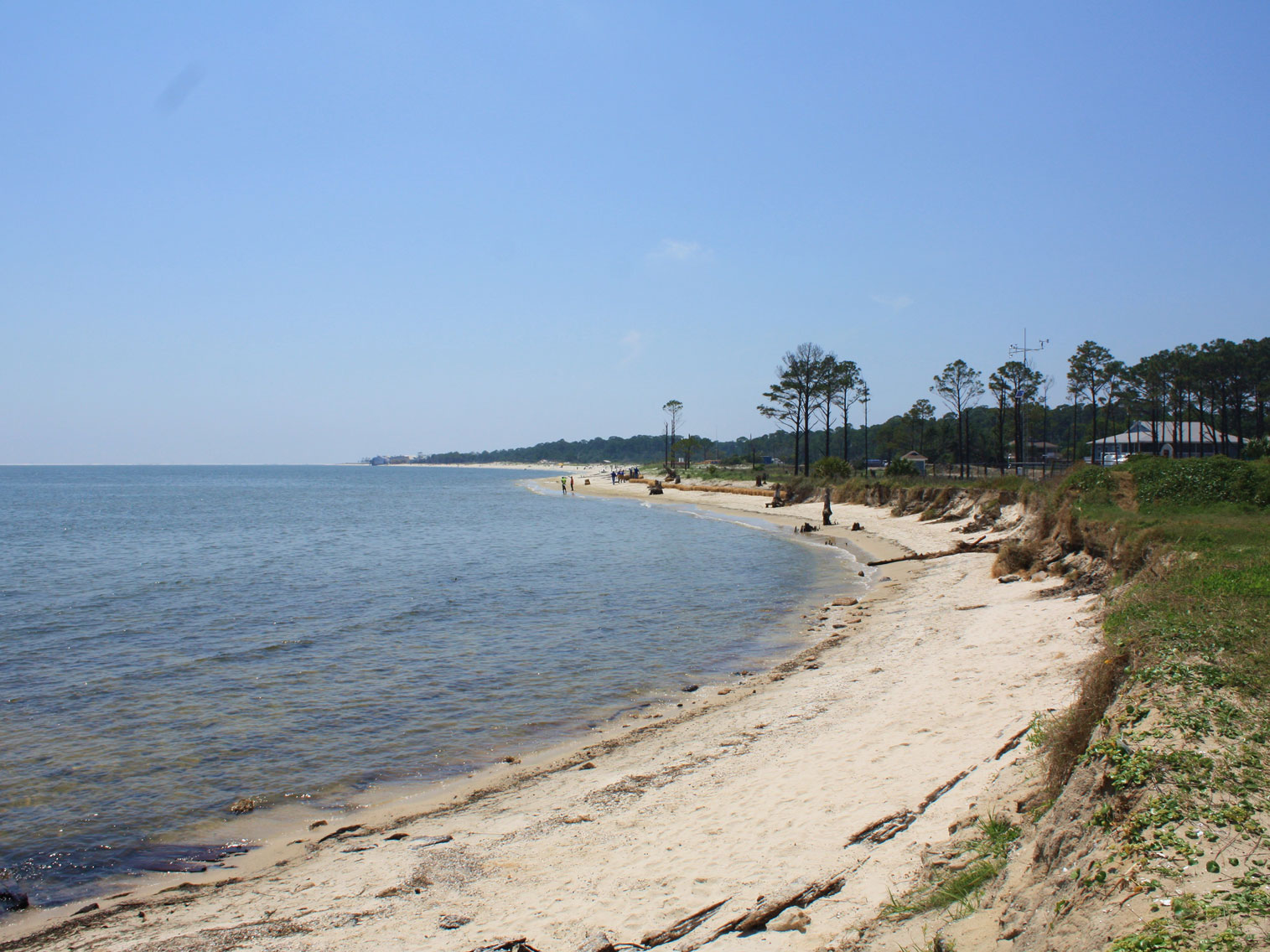State in the Southeastern region of the United States known as the "Heart of Dixie" and the "Cotton State" with its capital is Montgomery, and its largest city by population and area is Huntsville, its oldest city is Mobile, founded by French colonists in 1702 as the capital of French Louisiana and greater Birmingham is Alabama's largest metropolitan area and its economic center
Places to See in Alabama

Orange Beach
WeaponizingArchitecture, CC BY-SA 4.0, via Wikimedia Commons
Cities
Gulf Shores · Mobile · Orange Beach

Dauphin IslandJeffrey Reed, CC BY-SA 3.0, via Wikimedia Commons; Image Size Adjusted
Landmarks and Landscapes
Cheaha State Park · Dauphin Island
Alabama is in the Southeastern region of the United States. With a total of 1,500 miles (2,400 km) of inland waterways, Alabama has among the most of any state. Alabama is nicknamed the Yellowhammer State, after the state bird. Alabama is also known as the "Heart of Dixie" and the "Cotton State". Alabama's capital is Montgomery, and its largest city by population and area is Huntsville. Its oldest city is Mobile, founded by French colonists in 1702 as the capital of French Louisiana. Greater Birmingham is Alabama's largest metropolitan area and its economic center.
The state's geography is diverse, with the north dominated by the mountainous Tennessee Valley and the south by Mobile Bay, a historically significant port. Today, American football, particularly at the college level at schools like Auburn University, the University of Alabama, Alabama A&M University, Alabama State University, Troy University, the University of South Alabama, and Jacksonville State University is a major part of the state's culture.
Originally home to many native tribes, present-day Alabama was a Spanish territory beginning in the sixteenth century until the French acquired it in the early eighteenth century. The British won the territory in 1763 until losing it in the American Revolutionary War. Spain held Mobile as part of Spanish West Florida until 1813. In December 1819, Alabama was recognized as a state. During the antebellum period, Alabama was a major producer of cotton, and widely used African American slave labor. In 1861, the state seceded from the United States to become part of the Confederate States of America, with Montgomery acting as its first capital, and rejoined the Union in 1868.
High-profile events such as the Selma to Montgomery march made the state a major focal point of the civil rights movement in the 1950s and 1960s.
The European-American naming of the Alabama River and state was derived from the Alabama people, a Muskogean-speaking tribe whose members lived just below the confluence of the Coosa and Tallapoosa rivers on the upper reaches of the river.
The civil rights movement had notable events in Alabama, including the Montgomery bus boycott (1955-1956), Freedom Rides in 1961, and 1965 Selma to Montgomery marches. These contributed to Congressional passage and enactment of the Civil Rights Act of 1964 and Voting Rights Act of 1965 by the U.S. Congress.
] About three-fifths of the land area is part of the Gulf Coastal Plain, a gentle plain with a general descent towards the Mississippi River and the Gulf of Mexico. The North Alabama region is mostly mountainous, with the Tennessee River cutting a large valley and creating numerous creeks, streams, rivers, mountains, and lakes.
The state ranges in elevation from sea level at Mobile Bay to more than 2,000 feet (610 m) in the northeast, to Mount Cheaha at 2,413 ft (735 m).
Areas in Alabama administered by the National Park Service include Horseshoe Bend National Military Park near Alexander City; Little River Canyon National Preserve near Fort Payne; Russell Cave National Monument in Bridgeport; Tuskegee Airmen National Historic Site in Tuskegee; and Tuskegee Institute National Historic Site near Tuskegee. Additionally, Alabama has four National Forests: Conecuh, Talladega, Tuskegee, and William B. Bankhead. Alabama also contains the Natchez Trace Parkway, the Selma To Montgomery National Historic Trail, and the Trail of Tears National Historic Trail.
Notable natural wonders include: the "Natural Bridge" rock, the longest natural bridge east of the Rockies, located just south of Haleyville; Cathedral Caverns in Marshall County, named for its cathedral-like appearance, features one of the largest cave entrances and stalagmites in the world; Ecor Rouge in Fairhope, the highest coastline point between Maine and Mexico; DeSoto Caverns in Childersburg, the first officially recorded cave in the United States; Noccalula Falls in Gadsden features a 90-foot waterfall; Dismals Canyon near Phil Campbell, home to two waterfalls, six natural bridges and allegedly served as a hideout for legendary outlaw Jesse James; Stephens Gap Cave in Jackson County boasts a 143-foot pit, two waterfalls and is one of the most photographed wild cave scenes in America; Little River Canyon near Fort Payne, one of the nation's longest mountaintop rivers; Rickwood Caverns near Warrior features an underground pool, blind cave fish and 260-million-year-old limestone formations; and the Walls of Jericho canyon on the Alabama-Tennessee state line.
A 5-mile (8 km)-wide meteorite impact crater is located in Elmore County, just north of Montgomery. Called the Wetumpka crater, the site includes the area the 1,000-foot (300 m)-wide meteorite hit about 80 million years ago. The hills just east of downtown Wetumpka showcase the eroded remains of the impact crater that was blasted into the bedrock, with the area labeled the Wetumpka crater or astrobleme ("star-wound") because of the concentric rings of fractures and zones of shattered rock that can be found beneath the surface.
Mobile is known for having the oldest organized Mardi Gras celebration in the United States, beginning in 1703. It was also host to the first formally organized Mardi Gras parade in the United States in 1830, a tradition that continues to this day. Mardi Gras is an official state holiday in Mobile and Baldwin counties.
College football is extremely popular in Alabama, particularly the University of Alabama Crimson Tide and Auburn University Tigers, rivals in the Southeastern Conference.
This article uses material from the Wikipedia article "Alabama" which is released under the Creative Commons Attribution-Share-Alike License 3.0